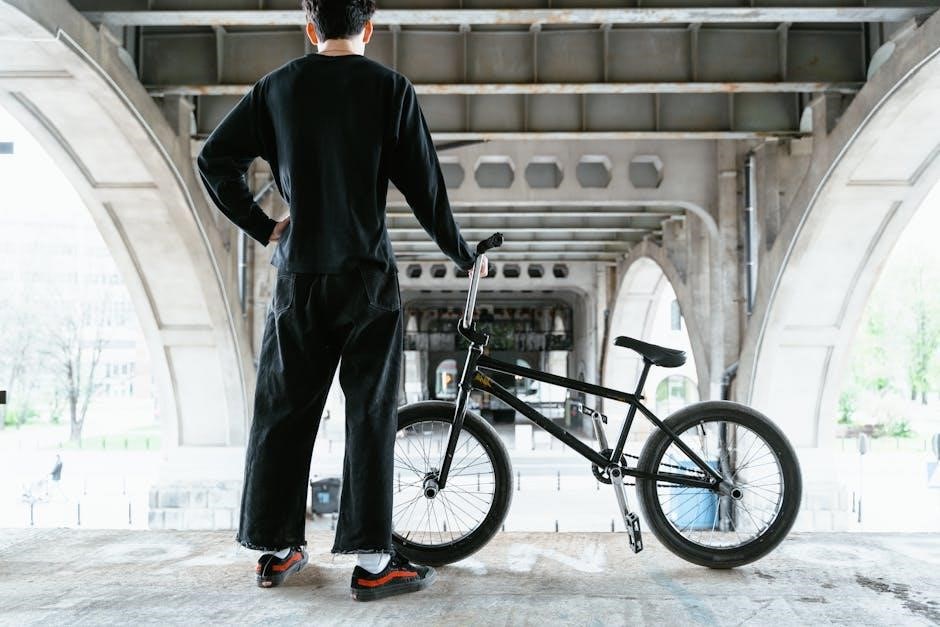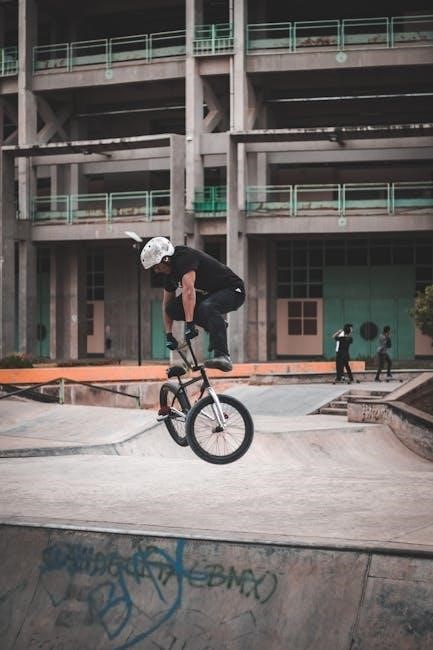Discover expert tips on cycling attire for varying temperatures, ensuring comfort, performance, and safety. This guide offers tailored advice for every climate, from scorching heat to icy cold;
Why Clothing Choice Matters for Cycling Comfort and Performance
Clothing choice is crucial for cycling comfort and performance, as it directly impacts how your body regulates temperature, manages moisture, and protects against the elements. The right gear enhances breathability, reduces chafing, and maintains optimal body temperature, ensuring you stay comfortable during long rides. Proper cycling attire also improves aerodynamics and provides padding in key areas, boosting efficiency and reducing fatigue. By selecting appropriate fabrics and layers, you can adapt to varying conditions, keeping your focus on the ride rather than discomfort.
Hot Weather Cycling (Above 70°F/21°C)
For hot weather cycling above 70°F/21°C, choose breathable, moisture-wicking fabrics. Opt for short-sleeve jerseys, lightweight bib shorts, and minimal layering to stay cool and dry. Lightweight socks and ventilated shoes enhance comfort during intense rides.
Moisture-Wicking Fabrics and Minimal Layering
Opt for lightweight, breathable, and moisture-wicking fabrics to keep cool in high temperatures. Avoid heavy or thick materials that trap heat. Minimal layering is key—stick to a short-sleeve jersey and padded shorts for optimal ventilation. These fabrics pull sweat away from your skin, drying quickly to prevent chafing and discomfort. Avoid cotton as it retains moisture, making you feel clammy. Instead, choose synthetic or merino wool blends designed for high performance in warm conditions. This ensures you stay cool, dry, and comfortable during intense rides.
Short-Sleeve Jerseys and Padded Shorts
Short-sleeve jerseys are ideal for warm weather, offering breathability and moisture-wicking properties. Look for lightweight, quick-drying fabrics like polyester or merino wool blends. Padded shorts are essential for comfort during long rides, providing cushioning in key areas. Opt for bib shorts or waist shorts with a seamless chamois for reduced friction. These pieces ensure freedom of movement and comfort, keeping you cool and dry in high temperatures. Avoid cotton as it retains moisture, making you feel clammy and uncomfortable during intense rides.
Lightweight Socks and Ventilated Shoes
Lightweight socks made from breathable, moisture-wicking fabrics like merino wool or synthetic blends are ideal for warm weather cycling. They keep feet dry and prevent blisters. Ventilated shoes with mesh panels enhance airflow, reducing heat buildup. Look for shoes with drainage holes to expel sweat and water. Avoid cotton socks, as they retain moisture and can lead to discomfort. Proper ventilation and lightweight materials ensure your feet stay cool and comfortable during long rides in hot conditions.
Essential Accessories: Sunglasses and Lightweight Gloves
Sunglasses are crucial for protecting your eyes from UV rays, reducing glare, and shielding them from wind and debris. Opt for lightweight, polarized lenses with good ventilation. Lightweight gloves provide a secure grip, absorb sweat, and offer padding to reduce hand fatigue. Choose breathable materials like mesh panels to keep hands cool and dry. These accessories enhance comfort and visibility, allowing you to focus on your ride without distractions.

Warm Weather Cycling (64°F-77°F/18°C-25°C)
Opt for moisture-wicking fabrics, lightweight jerseys, and minimal layering to stay cool. Accessories like sunglasses and gloves enhance comfort and grip without overheating.
Arm and Knee Warmers for Flexibility
Arm and knee warmers are versatile for fluctuating temperatures, offering light insulation without overheating. They provide breathability and moisture-wicking properties, keeping you dry and comfortable. Easy to remove, they allow quick adjustments as conditions change, making them ideal for rides that transition from cool to warm. Their sleek design ensures minimal bulk while maintaining flexibility, allowing full range of motion for optimal cycling performance. Perfect for layering, they adapt effortlessly to varying weather conditions, enhancing your riding experience.
Base Layers for Temperature Regulation
A high-quality base layer is essential for maintaining body temperature during rides. Choose moisture-wicking fabrics like merino wool or synthetic materials to keep sweat away from your skin. These layers help regulate your core temperature, preventing overheating in warmer conditions and cold buildup in cooler weather; A snug fit ensures optimal performance, while breathable designs enhance comfort. Base layers are the foundation of a smart cycling wardrobe, adapting to varied temperatures and riding intensities seamlessly. They are a must-have for any serious cyclist, regardless of the season.
Lightweight Windbreakers and Gilets
Lightweight windbreakers and gilets are versatile additions to your cycling wardrobe, offering protection from wind and light rain while maintaining breathability. Designed to be easily stowed in a jersey pocket, they provide an extra layer of warmth during cool starts or descents. Look for moisture-wicking fabrics and a streamlined fit to enhance performance. These pieces are ideal for transitional weather, allowing you to adapt to changing conditions without compromising comfort or mobility. They’re a practical choice for riders seeking flexibility in mild to cool temperatures.

Cool Weather Cycling (50°F-63°F/10°C-17°C)
Opt for long-sleeve jerseys, tights, or leg warmers, paired with a thermal base layer and lightweight windbreaker. Add gloves and warm socks for comfort and warmth.

Long-Sleeve Jerseys and Tights or Leg Warmers
For cool weather, opt for a breathable long-sleeve jersey paired with cycling tights or leg warmers; These provide insulation while maintaining moisture-wicking properties to keep you dry. Tights offer full-leg coverage,
while leg warmers allow flexibility to adjust coverage as temperatures fluctuate. Both options protect against wind chill and cooler air, ensuring comfort during rides in 50°F-63°F (10°C-17°C) conditions. Choose materials like merino wool or synthetic blends for optimal warmth and performance. This combination balances comfort and functionality for crisp, cool weather cycling.
Thermal Base Layers and Fleece-Lined Jackets
A thermal base layer is essential for cool weather cycling, as it wicks moisture and regulates body temperature. Pair it with a fleece-lined jacket for added insulation against the chill. These layers work together to retain warmth while allowing breathability, preventing overheating during intense rides. Opt for materials like merino wool or high-quality synthetics for superior performance. This combination is ideal for maintaining comfort and warmth in temperatures between 50°F-63°F (10°C-17°C), ensuring you stay cozy without compromising mobility or performance.
Full-Finger Gloves and Warm Socks
Full-finger gloves and warm socks are crucial for cool weather cycling, providing insulation and protection from the cold. Look for gloves with padded palms and breathable materials to maintain dexterity and warmth. Merino wool or synthetic socks are ideal, as they wick moisture and retain heat. These essentials prevent numbness and discomfort, ensuring better control and comfort during your ride in temperatures between 50°F-63°F (10°C-17°C). They are vital for maintaining circulation and overall riding comfort.

Cold Weather Cycling (32°F-49°F/0°C-9°C)
Thermal bib tights, long-sleeve jerseys, and insulated jackets are essential for cold rides. Pair with thermal base layers and heavy-duty overshoe covers for maximum warmth and protection.
Thermal Bib Tights and Long-Sleeve Jerseys
Thermal bib tights and long-sleeve jerseys are essential for cold weather cycling, providing insulation and protecting against wind. Bib tights offer a snug fit and coverage for legs, while long-sleeve jerseys keep your torso warm. Look for materials like merino wool or synthetic fabrics that wick moisture and retain warmth. Layering these with a thermal base layer and jacket ensures optimal temperature regulation. Choose gear with breathable, moisture-wicking properties to prevent overheating during intense rides. Proper fit is crucial for comfort and performance in cold conditions.
Heavy-Duty Jackets and Thermal Overshoes
Heavy-duty jackets and thermal overshoes are vital for cold weather cycling, offering protection against harsh conditions. A waterproof and windproof jacket helps retain body heat, while thermal overshoes prevent cold air from penetrating to your feet. These items are designed to withstand freezing temperatures and maintain warmth without compromising mobility; Look for breathable materials that wick moisture and ensure a snug, aerodynamic fit. Combined with thermal base layers, they provide a reliable defense against cold, keeping you comfortable and focused on your ride.
Thick Gloves, Warm Socks, and Headgear
Thick gloves, warm socks, and headgear are essential for cold weather cycling. Insulated gloves prevent numbness and maintain dexterity, while warm socks made from materials like merino wool or synthetic fabrics keep feet dry and cozy. Headgear, such as balaclavas or thermal hats, protects against wind chill and heat loss. These accessories ensure extremities stay warm, allowing riders to focus on performance even in freezing temperatures. Proper layering with these items is crucial for comfort and safety during cold-weather rides.

Frigid Weather Cycling (Below 32°F/0°C)
For extreme cold, prioritize maximum insulation with thermal bib tights, long-sleeve jerseys, and heavy-duty jackets. Thermal overshoes, face protection, and layered gloves are essential for wind and frost protection.
Maximum Insulation with Heavy-Duty Fabrics
Choose heavy-duty fabrics like thermal bib tights and long-sleeve jerseys for extreme cold. These materials retain body heat, wick moisture, and provide wind resistance. Pair with a thick, insulated jacket to shield against biting winds and frost. Thermal bib tights are crucial for leg warmth, while long-sleeve jerseys offer torso insulation. Look for materials with high breathability to prevent overheating during intense rides. These fabrics ensure optimal comfort and protection in frigid conditions, keeping you warm and dry.
Multiple Layers and Face Protection
For extreme cold, layering is crucial. Start with a thermal base layer, add a fleece-lined mid-layer, and finish with a windproof outer shell. Face protection is essential to prevent windburn and frostbite. Opt for a balaclava or neck gaiter to cover your face and neck, and consider goggles or glasses with anti-fog lenses. These layers trap warmth, protect against harsh winds, and ensure visibility. Adaptability is key—adjust layers as needed to maintain comfort and prevent overheating during intense efforts.
Specialized Gloves and Overshoes for Extreme Cold
For frigid temperatures, specialized gloves with thermal insulation, waterproofing, and grip are essential. Look for gloves with multiple layers, including a fleece or synthetic liner, to trap warmth and prevent moisture buildup. Thermal overshoes are equally critical—opt for waterproof, breathable models with a snug fit to protect your shoes from snow and ice. Both gloves and overshoes should prioritize dexterity and visibility, ensuring you can handle your bike safely while maintaining circulation in extreme cold conditions.
Layering Techniques for Variable Conditions
Mastering layering is key to cycling comfort. Combine a breathable base layer, insulating mid-layer, and waterproof outer shell to adapt to changing temperatures and weather conditions seamlessly.
Base, Mid, and Outer Layers Explained
The base layer wicks moisture, regulating body temperature. The mid-layer provides insulation, while the outer layer shields from wind and rain. This system ensures versatility and comfort in varying conditions, allowing riders to adjust easily.
Adapting to Changing Temperatures During Rides
Monitor weather forecasts and adjust your clothing as conditions shift. Remove layers as temperatures rise and re-add them when cooling down. Zippered jerseys allow ventilation, while lightweight accessories like arm warmers can be stashed in pockets. Choose breathable, moisture-wicking fabrics to maintain comfort. Adjusting your gear mid-ride ensures optimal performance and prevents overheating or chilling, keeping you comfortable throughout your journey.